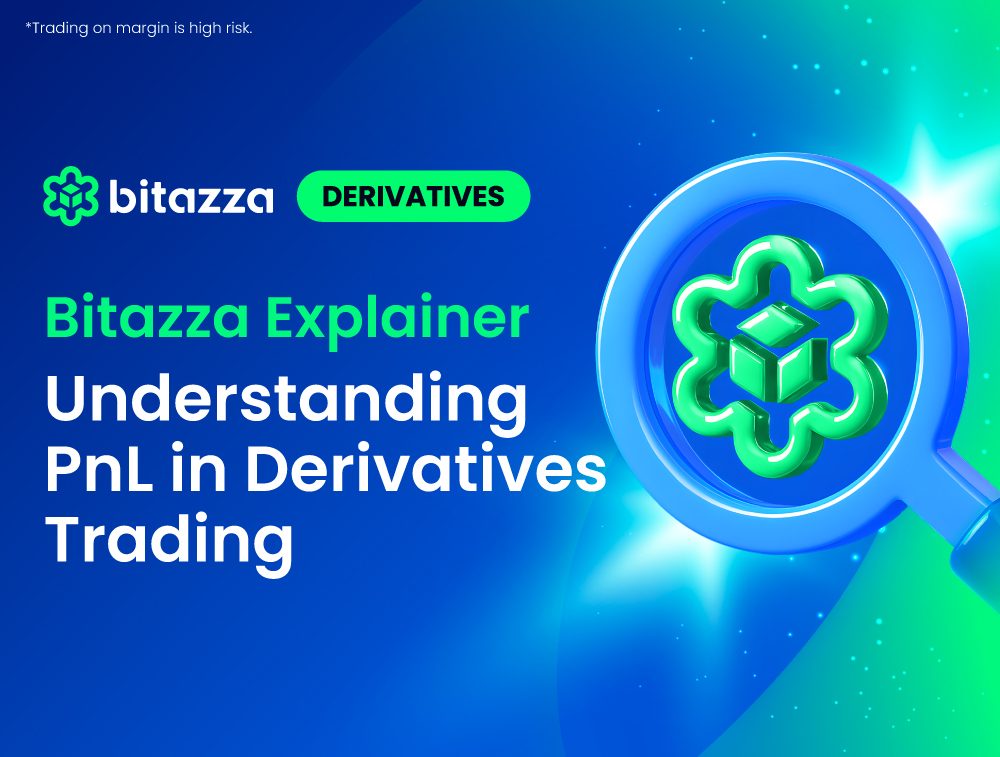Share this
Understanding PnL in Derivatives Trading: What Every Trader Should Know

When trading derivatives, it’s not just the market direction that matters—it’s how you track your trades. That’s where PnL comes in.
PnL, short for Profit and Loss, shows how your trades are performing and is a key metric used to measure trading outcomes. Whether you’re managing open positions or reviewing completed trades, knowing how to interpret your PnL is essential to managing risk and improving your strategy.
In this article, we’ll break down the four main types of PnL metrics you’ll see when trading Derivatives on Bitazza: Unrealized PnL, Realised PnL, Net Realised PnL, and ROI.
1. Unrealized PnL
Unrealized PnL represents the profit or loss from open trades that have not yet been closed. Since the position is still active, this figure is based on the current market price and can change rapidly.
For example, if you opened a long BTC/USDT position at $28,000 and the current price is $29,000, you may see a positive Unrealized PnL. However, because the position is not closed, this is not locked in, and it can quickly reverse depending on market movement.
Key Point:
Unrealized PnL is a floating value that reflects potential gains or losses, but it only becomes final once the position is closed.
2. Realised PnL
Realised PnL is the final profit or loss you incur when a position is closed. This figure reflects the difference between your entry and exit prices, multiplied by the position size, without yet factoring in trading costs.
It is the clearest indicator of whether a trade was profitable or resulted in a loss.
Example:
If you entered a short position and closed it at a lower price, your Realised PnL would reflect the profit based on that difference. Conversely, if the trade moved against you, your Realised PnL would show a loss.
3. Net Realised PnL
Net Realised PnL takes the Realised PnL one step further by factoring in trading fees, including commissions and swap (funding) charges. This provides a more accurate view of your actual realised return after costs.
Because fees are an integral part of leveraged trading, Net Realised PnL is important for assessing overall trade performance.
Key Point:
Even if your Realised PnL is positive, high fees can reduce your net result—or even turn a small profit into a loss.
4. ROI (Return on Investment)
ROI is the percentage gain or loss you make on a trade, calculated relative to the amount of margin you committed to that trade.
It’s a helpful way to compare the performance of different trades, regardless of position size.
Formula:
ROI (%) = (Net Realised PnL / Margin Used) × 100
ROI can vary significantly based on leverage and position sizing. A high ROI may indicate strong trade efficiency, but it also reflects high exposure if leverage is aggressive.
Why These Metrics Matter
Understanding your PnL helps you do more than check performance—it helps you:
• Measure the effectiveness of your strategy
• Track risk exposure and cost efficiency
• Make informed decisions when managing or closing positions
These figures are not guarantees of success, but tools that support disciplined trading.
Final Thoughts
Derivatives trading involves both opportunity and risk. Knowing how to read your PnL, both realised and unrealized, can help you stay informed and better manage your positions.
Here’s a quick recap:
• Unrealized PnL shows floating profit/loss on open positions
• Realised PnL reflects profit/loss when a position is closed
• Net Realised PnL includes commissions and swap fees
• ROI shows percentage return based on capital used
Ready to take the next step in your trading journey? Download the Bitazza app and track your trades with clarity. Want to learn more about Derivatives? Check out our blog
Share this
- Crypto 101 (75)
- Trading (68)
- Crypto Weekly (48)
- Educational (43)
- Bitazza 101 (41)
- Featured (19)
- Missions (8)
- Market (6)
- Bitazza Insight (5)
- Research (5)
- Derivatives (4)
- TradingView (4)
- Education (3)
- Futures Trading (3)
- Freedom Shards (1)
- Freedom Token (FDM) (1)
- Intermediate (1)
- Product and features (1)
- Tether (1)
- Tether (USDt) (1)
- crypto exchange (1)
- December 2025 (13)
- November 2025 (6)
- October 2025 (10)
- September 2025 (8)
- August 2025 (17)
- July 2025 (29)
- June 2025 (13)
- May 2025 (14)
- April 2025 (12)
- March 2025 (8)
- February 2025 (8)
- January 2025 (8)
- December 2024 (7)
- November 2024 (5)
- October 2024 (14)
- September 2024 (9)
- August 2024 (14)
- July 2024 (3)
- June 2024 (48)
No Comments Yet
Let us know what you think